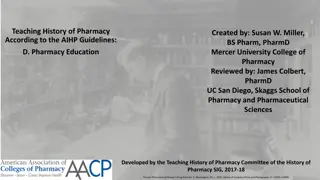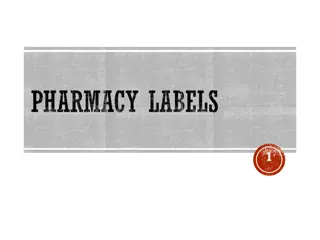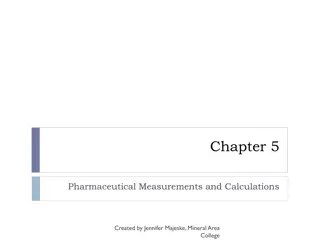Understanding Interfaces in Physical Pharmacy
Interfaces play a crucial role in physical pharmacy, dividing phases like solid, liquid, and gas. Liquid interfaces involve surface tension due to cohesive and adhesive forces. This chapter explores the classification and properties of interfaces, shedding light on the behavior of molecules at the boundary between phases.
Download Presentation

Please find below an Image/Link to download the presentation.
The content on the website is provided AS IS for your information and personal use only. It may not be sold, licensed, or shared on other websites without obtaining consent from the author. Download presentation by click this link. If you encounter any issues during the download, it is possible that the publisher has removed the file from their server.
E N D
Presentation Transcript
Interfacial Phenomena MARTIN S PHYSICAL PHARMACY AND PHARMACEUTICAL SCIENCES chapter 15 lecturer Methaq Hamad
Several types of interface can exist, depending on whether the two adjacent phases are in the solid, liquid, or gaseous state. For convenience, these various combinations are divided into two groups, namely, liquid interfaces and solid interfaces.
Interfaces When phases exist together, the boundary between two of them is termed an interface. The properties of the molecules forming the interface are often sufficiently different from those in the bulk of each phase that they are referred to as forming an interfacial phase.
Liquid Interfaces Surface and Interfacial Tensions In the liquid state, the cohesive forces between adjacent molecules Molecules in the bulk liquid are surrounded in all directions by other molecules for which they have an equal attraction, as shown in following Figure are well developed. the
The molecules at the surface (i.e., at the liquidair interface) can only develop attractive cohesive forces with other liquid molecules that are situated below and adjacent to them. They can develop adhesive forces of attraction with the molecules constituting the other phase involved in the interface, although, in the case of the liquid gas interface, this adhesive force of attraction is small. The net effect is that the molecules at the surface of the liquid experience an inward force toward the bulk, as shown in previous Figure Such a force pulls the molecules of the interface together and, as a result, contracts the surface, resulting in a surface tension.
It is similar to the situation that exists when an object dangling over the edge of a cliff on a length of rope is pulled upward by a man holding the rope and walking away from the edge of the top of the cliff. This analogy to surface tension is sketched in the following Figure
Surface tension a force pulling the molecules of the interface together resulting in a contracted surface. It is a force per unit length applied parallel to the surface . Unit in dynes/cm or N/m
Interfacial tension is the force per unit length existing at the interface immiscible liquid phases and, like surface tension, has the units of dynes/cm. Although, in the general sense, all tensions may be referred to as interfacial tensions, this term is most often used for the attractive force between immiscible liquids. Later, we will use the term interfacial tension for the force between two liquids, LL, between two solids, SS, and at a liquid solid interface, LS between two
The term surface tension is reserved for liquid vapor LV, tensions. These are often written simply as L and S, respectively. interfacial tensions are less than surface tensions because the adhesive forces between two liquid phases forming an interface are greater than when a liquid and a gas phase exist together. It follows that if two liquids are completely miscible, no interfacial tension exists between them. and solid vapor, SV,
Surface Free Energy To move a molecule from the inner layers to the surface , work must be done against the force of surface tension .In other words , each molecule near the surface of liquid of possesses a certain excess of potential compared to the molecules in the bulk of the liquid . The higher the surface of the liquid, the more molecules have this excessive potential energy energy as
Therefore , if the surface of the liquid increases , e.g. when water is broken into a fine spray), the energy of the liquid also increases. energy is proportional to the size of the free surface, it is called a surface free energy. Because this
Each molecule of the liquid has a tendency to move inside the liquid from the surface ; therefore the liquid takes form with minimal free surface and with minimal surface energy . for example , liquid assume a spherical shape because a sphere has the smallest surface area per unit volume. droplets tend to
Surface Free energy W = A where W is work done or surface free energy increase expess in ergs(dyne cm); is surface tension in dynes/cm and A is increase in area in cm2. Q. What in the work required to increase area of a liquid droplet by 10 cm2if the surface tension is 49 dynes/cm? W = 49 dynes/cm x 10 cm2= 490 ergs
Spreading Coefficient When oleic acid is placed on the surface of a water , a film will be formed if the force of adhesion between oleic acid molecules and water molecules is greater than the cohesive forces between the oleic acid molecules themselves.
Work of adhesion (Wa), which is the energy required to break the attraction between the unlike molecules(water to oil) Figure 15-7 Representation of the work of adhesion involved in separating a sublayer and an overlaying liquid.
Work = Surface tension x Unit area change Accordingly, it is seen in figure 15-7 that the work done is equal to the newly created surface tensions ,yL interfacial tension ,YLS that has been destroyed in the process. Wa= YL+YS-YLS and YS ,minus the
Work of cohesion ( Wc ), required to separate the molecules of the spreading liquid so that it can flow over the sublayer. Figure 15-8 Representation of the work of cohesion involved in separating like molecules in a liquid.
Obviously , no interfacial tension between the like molecules of the liquid , and when the hypothetical 1 Cm2cylinder in figure 15-8 is divided , two new surfaces are created each with surface tension of YL, therefore the work of cohesion is Wc =2YL
Spreading of oil to water occurs if the work of adhesion (a measure of the force of attraction between the oil and the water) is greater than the work of cohesion. The term (Wa-Wc) is known as the Spreading coefficient(S) If it is Positive the oil will spread over a water surface. S=(YL+YS-YLS) -2YL rearrangement : S= Ys-YL-YLS Or S= Ys (YL+YLS)
Figure 15-9 shows a lens of material placed on a liquid surface (e.g., oleic acid on water), one sees that spreading occurs (S is positive) when the surface tension of the sublayer liquid is greater than the sum of the surface tension of the spreading liquid and the interfacial tension between the sublayer and the spreading liquid. If ( L + LS) is larger than S, the substance forms globules or a floating lens and fails to spread over the surface. An example of such a case is mineral oil on water.
Example 15-7 If the surface tension of water Ys is 72.8 dyne /cm at 20 C , the surface tension of benzene YL is 28.9 dyne/cm and the interfacial tension between benzene and water ,YLS, is 35 dyne /cm . What is the initial spreading coefficient? Answer: S = 72.8 - (28.9+ 35) = 8.9 dyne/cm Therefore, although benzene spreads initially on water, at equilibrium there is formed a saturated monolayer with the excess benzene (saturated with water) forming a lens.
In the case of organic liquids spread on water, it is found that although the initial spreading coefficient may be positive or negative, the final spreading coefficient always has a negative value. Duplex films of this type are unstable and form monolayers with the excess material remaining as a lens on the surface. It is important to consider the types of molecular structures that lead to high spreading coefficients. Oil spreads over water because it contains polar groups such as COOH or OH.
The initial spreading coefficients of some organic liquids on water at 20 C are listed in Table 15-4.
propionic acid and ethyl alcohol should have high values of S, as seen in Table 15-4. As the carbon chain of an acid, oleic acid, for example, increases, the ratio of polar nonpolar character decreases and the spreading coefficient on water decreases. Many nonpolar substances, such as liquid petrolatum (S = -13.4), fail to spread on water. Benzene spreads on water not because it is polar but because the cohesive forces between its molecules are much weaker than the adhesion for water.
Adsorption at Liquid Interfaces Surface free energy was defined previously as the work that must be done to increase the surface by unit area. As a result of such an expansion, more molecules must be brought from the bulk to the interface. The more work that has to be expended to achieve this, the greater is the surface free energy. Certain molecules and ions, when dispersed in the liquid, move of their own accord to the interface.
Their concentration at the interface then exceeds their concentration in the bulk of the liquid. the surface free energy and the surface tension of the system are automatically reduced. Such a phenomenon, where the added molecules are partitioned in favor of the interface, is termed adsorption, or, more correctly, positive adsorption Other materials (e.g., inorganic electrolytes) are partitioned in favor of the bulk, leading to negative adsorption and a corresponding increase in surface free energy and surface tension. Adsorption, as will be seen later, can also occur at solid interfaces.
Adsorption should not be confused with absorption. The former is solely a surface effect, whereas in absorption, the liquid or gas being absorbed penetrates into the capillary spaces of the absorbing medium. The taking up of water by a sponge is absorption; the concentrating of alkaloid molecules on the surface of clay is adsorption.
The applications of spreading coefficients in pharmacy should be fairly evident. The surface of the skin is bathed in an aqueous oily layer having a polar nonpolar character similar to that of a mixture of fatty acids. For a lotion with a mineral oil base to spread freely and evenly on the skin, its polarity and hence its spreading coefficient should be increased by the addition of a surfactant.
Surface-Active Agents It is the amphiphilic nature of surface-active agents that causes them to be adsorbed at interfaces, whether these are liquid gas or liquid liquid interfaces. Thus, in an aqueous dispersion of amyl alcohol, the polar alcoholic group is able to associate with the water molecules. The nonpolar portion is rejected, however, because the adhesive forces it can develop with water are small in comparison to the cohesive forces between adjacent water molecules
As a result, the amphiphile is adsorbed at the interface. The situation for a fatty acid at the air water and oil water interface is shown in Figure 15-10. At the air water interface, the lipophilic chains are directed upward into the air; at the oil water interface, they are associated with the oil phase.
For the amphiphile to be concentrated at the interface, it must be balanced with the proper amount of water- and oil-soluble groups. If the molecule is too hydrophilic, it remains within the body of the aqueous phase and exerts no effect at the interface. Likewise, if it is too lipophilic, it dissolves completely in the oil phase and little appears at the interface.
Reduction of surface and interfacial tension The reason for the reduction in the surface tension, When surfactant molecules adsorb at the water surface is that the surfactant molecules replace some of the water molecules in the surface and the forces of attraction between surfactant and water molecules are less than those between two water molecules, hence the contraction force is reduced.
Surfactants are classified as: Anionic Sodium Dodecylsulphate: CH3(CH2)11SO4-Na+ Cationic Dodecylaminehydrochloride: CH3(CH2)11NH3+Cl Non-ionic Polyethylene Oxides: e.g. CH3(CH2)11(O-CH2-CH2)nOH Spans (sorbitanesters) Tweens (polyoxyethylenesorbitanesters) Ampholytic Dodecyl betaine: C12H25N+(CH3)2(CH2COO
Hydrophilic-Lipophilic Balance(HLB) It is an arbitrary scale from 0 to 20 serve as a measure of the Hydrophilic/Lipophilic balance of a surfactant. Products with low HLB are more oil soluble. High HLB represents good water solubility. The oil phase of the oil water (o/w) emulsion requires a specific HLB, called the required hydrophilic lipophilic balance (RHLB). A different RHLB is required to form a water-in oil emulsion (w/o )from the same oil phase.
Fig. 15-11. A scale showing surfactant function on the basis of hydrophilic lipophilic balance (HLB) values. Key: O/W = oil in water.
Micelles Surfactants molecules aggregate in aqueous solution to form concentrations and temperature (Fig. 23-16). Surfactants have a hydrophilic polar head group attached to a long-chain lipophilic (nonpolar) tail. micelles at certain
The surface tension of a surfactant solution decreases progressively concentration as more surfactant molecules enter the surface or interfacial layer. However ,at acertain concentration this layer becomes saturated and an alternative means of shielding the hydrophobic group of the surfactant from the aqueous environment occurs through the formation of aggregates (usually spherical) of colloidal dimensions,called micelles. with increase of
Micelles are formed only when surfactants are present above a certain concentration, known as critical micelle concentration (CMC), which is characteristic for each surfactant. There is also a critical temperature requirement for micelle formation.
Fig. 16-4.Some probable shapes of micelles: (a) spherical micelle in aqueous media, (b) reversed micelle in nonaqueous media, and (c) laminar micelle, formed at higher amphiphile concentration, in aqueous media.
Surface tension decrease with increasing conc. Of surfactant until CMC is reached ,then become constant
The CMC decreases with an increase in the length of the hydrophobic chain. The addition of electrolytes surfactants decreases the CMC and increases the micellar size. The effect is simply explained in terms of a reduction in the magnitude of the forces of repulsion between the charged head groups in the micelle, allowing the micelles to grow and also reducing the work required for their formation. to ionic
Micellar Solubilization An important property of association colloids in solution is the ability of the micelles to increase the solubility of materials that are normally insoluble, or only slightly soluble, in the dispersion medium used . This phenomenon, known as solubilization. The location of the molecule undergoing solubilization in a micelle is related to the balance between the polar and nonpolar properties of the molecule
nonpolar molecules in aqueous systems of ionic surface-active agents would be located in the hydrocarbon core of the micelle, Polar solubilizates would tend to be adsorbed onto the micelle surface. Polar nonpolar molecules would tend to align themselves in an intermediate position within the surfactant molecules forming the micelle.
Adsorption at Solid Interfaces Adsorption of material at solid interfaces can take place from either an adjacent liquid or gas phase. The study of adsorption of gases arises in such diverse applications as the removal of objectionable odors from rooms. The principles of solid liquid adsorption are used in decolorizing solutions, adsorption chromatography, detergency, and wetting.
The SolidGas Interface The degree of adsorption of a gas by a solid depends on the chemical nature of the adsorbent (the material used to adsorb the gas) and the adsorbate (the substance being adsorbed), the surface area of the adsorbent, the temperature the partial pressure of the adsorbed gas.























